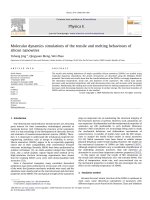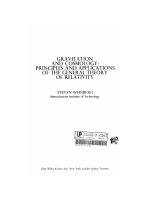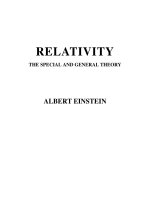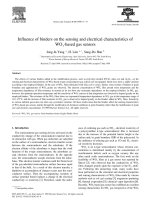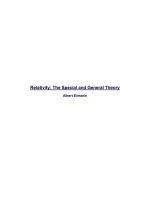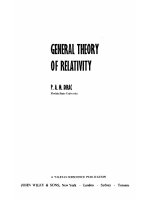- Trang chủ >>
- Khoa Học Tự Nhiên >>
- Vật lý
The special and general theory of relativity a einstein
Bạn đang xem bản rút gọn của tài liệu. Xem và tải ngay bản đầy đủ của tài liệu tại đây (1.24 MB, 152 trang )
RELATIVITY
THE SPECIAL AND GENERAL THEORY
ALBERT EINSTEIN
RELATIVITY
THE SPECIAL AND GENERAL THEORY
BY
ALBERT EINSTEIN, Ph.D.
PROFESSOR OF PHYSICS IN THE UNIVERSITY OF BERLIN
TRANSLATED BY
ROBERT W. LAWSON, D.Sc., F. Inst. P.
UNIVERSITY OF SHEFFIELD
1920 EDITION
COPYRIGHT INFORMATION
Book:
Relativity
:
The Special and General Theory
Author: Albert Einstein, 1879–1955
First published: 1920
This PDF file contains the text of the first English translation of
Über die spezielle und die allgemeine Relativitätstheorie
, published
in 1920. (The index has not been included. A few misprints in the
original text have been corrected. They are marked by footnotes
enclosed in square brackets and signed “J.M.”)
The original book is
in the public domain in the United States. However, since Einstein
died in 1955, it is still under copyright in most other countries, for
example, those that use the life of the author + 50 years or life + 70
years for the duration of copyright. Readers outside the United States
should check their own countries’ copyright laws to be certain they
can legally download this ebook.
v
PREFACE
HE present book is intended, as far as possible, to give an exact
insight into the theory of Relativity to those readers who, from
a general scientific and philosophical point of view, are
interested in the theory, but who are not conversant with the
mathematical apparatus
1
of theoretical physics. The work presumes a
standard of education corresponding to that of a university
matriculation examination, and, despite the shortness of the book, a
fair amount of patience and force of will on the part of the reader. The
author has spared himself no pains in his endeavour to present the
main ideas in the simplest and most intelligible form, and on the
whole, in the sequence and connection in which they actually
originated. In the interest of clearness, it appeared to me inevitable
that I should repeat myself frequently, without paying the slightest
attention to the elegance of the presentation. I adhered scrupulously to
the precept of that brilliant theoretical physicist, L. Boltzmann,
according to whom matters of elegance ought to be left to the tailor
and to the cobbler. I make no pretence of having withheld from the
reader difficulties which are inherent to the subject. On the other
hand, I have purposely treated the empirical physical foundations of
the theory in a “step-motherly” fashion, so that readers unfamiliar
with physics may not feel like the wanderer who was unable to see
1
The mathematical fundaments of the special theory of relativity are to be found in the
original papers of H. A. Lorentz, A. Einstein, H. Minkowski published under the title Das
Relativitätsprinzip (The Principle of Relativity) in B. G. Teubner’s collection of monographs
Fortschritte der mathematischen Wissenschaften (Advances in the Mathematical Sciences),
also in M. Laue’s exhaustive book Das Relativitäts prinzip—published by Friedr. Vieweg &
Son, Braunschweig. The general theory of relativity, together with the necessary parts of the
theory of invariants, is dealt with in the author’s book Die Grundlagen der allgemeinen
Relativitätstheorie (The Foundations of the General Theory of Relativity)—Joh. Ambr.
Barth, 1916; this book assumes some familiarity with the special theory of relativity.
T
vi
the forest for trees. May the book bring some one a few happy hours
of suggestive thought!
A. EINSTEIN
December, 1916
NOTE TO THE THIRD EDITION
N the present year (1918) an excellent and detailed manual on the
general theory of relativity, written by H. Weyl, was published by
the firm Julius Springer (Berlin). This book, entitled
Raum—
Zeit—Materie
(Space—Time—Matter), may be warmly
recommended to mathematicians and physicists.
I
vii
BIOGRAPHICAL NOTE
LBERT EINSTEIN is the son of German-Jewish parents. He
was born in 1879 in the town of Ulm, Würtemberg, Germany.
His schooldays were spent in Munich, where he attended the
Gymnasium
until his sixteenth year. After leaving school at Munich,
he accompanied his parents to Milan, whence he proceeded to
Switzerland six months later to continue his studies.
From 1896 to 1900 Albert Einstein studied mathematics and
physics at the Technical High School in Zurich, as he intended
becoming a secondary school (
Gymnasium
) teacher. For some time
afterwards he was a private tutor, and having meanwhile become
naturalised, he obtained a post as engineer in the Swiss Patent Office
in 1902, which position he occupied till 1909. The main ideas
involved in the most important of Einstein’s theories date back to this
period. Amongst these may be mentioned:
The Special Theory of
Relativity
,
Inertia of Energy
,
Theory of the Brownian Movement
, and
the
Quantum-Law of the Emission and Absorption of Light
(1905).
These were followed some years later by the
Theory of the Specific
Heat of Solid Bodies
, and the fundamental idea of the
General Theory
of Relativity
.
During the interval 1909 to 1911 he occupied the post of
Professor
Extraordinarius
at the University of Zurich, afterwards
being appointed to the University of Prague, Bohemia, where he
remained as Professor
Ordinarius
until 1912. In the latter year
Professor Einstein accepted a similar chair at the
Polytechnikum
,
Zurich, and continued his activities there until 1914, when he
received a call to the Prussian Academy of Science, Berlin, as
successor to Van’t Hoff. Professor Einstein is able to devote himself
freely to his studies at the Berlin Academy, and it was here that he
A
viii
succeeded in completing his work on the
General Theory of Relativity
(1915–17). Professor Einstein also lectures on various special
branches of physics at the University of Berlin, and, in addition, he is
Director of the Institute
*
for Physical Research of the
Kaiser Wilhelm
Gesellschaft
.
Professor Einstein has been twice married. His first wife, whom
he married at Berne in 1903, was a fellow-student from Serbia. There
were two sons of this marriage, both of whom are living in Zurich,
the elder being sixteen years of age. Recently Professor Einstein
married a widowed cousin, with whom he is now living in Berlin.
R. W. L.
[
*
This word was misprinted Institnte in the original book.—J.M.]
ix
TRANSLATOR’S NOTE
N presenting this translation to the English-reading public, it is
hardly necessary for me to enlarge on the Author’s prefatory
remarks, except to draw attention to those additions to the book
which do not appear in the original.
At my request, Professor Einstein kindly supplied me with a
portrait of himself, by one of Germany’s most celebrated artists.
Appendix III, on “The Experimental Confirmation of the General
Theory of Relativity,” has been written specially for this translation.
Apart from these valuable additions to the book, I have included a
biographical note on the Author, and, at the end of the book, an Index
and a list of English references to the subject. This list, which is more
suggestive than exhaustive, is intended as a guide to those readers
who wish to pursue the subject farther.
I desire to tender my best thanks to my colleagues Professor S. R.
Milner, D.Sc., and Mr. W. E. Curtis, A.R.C.Sc., F.R.A.S., also to my
friend Dr. Arthur Holmes, A.R.C.Sc., F.G.S., of the Imperial College,
for their kindness in reading through the manuscript, for helpful
criticism, and for numerous suggestions. I owe an expression of
thanks also to Messrs. Methuen for their ready counsel and advice,
and for the care they have bestowed on the work during the course of
its publication.
ROBERT W. LAWSON
T
HE
P
HYSICS
L
ABORATORY
T
HE
U
NIVERSITY
OF
S
HEFFIELD
June 12, 1920
I
x
CONTENTS
PART I
THE SPECIAL THEORY OF RELATIVITY
I.
Physical Meaning of Geometrical Propositions
II.
The System of Co-ordinates
III.
Space and Time in Classical Mechanics
IV.
The Galileian System of Co-ordinates
V.
The Principle of Relativity (in the Restricted Sense)
VI.
The Theorem of the Addition of Velocities employed in
Classical Mechanics
VII.
The Apparent Incompatibility of the Law of
Propagation of Light with the Principle of
Relativity
VIII.
On the Idea of Time in Physics
IX.
The Relativity of Simultaneity
X.
On the Relativity of the Conception of Distance
XI.
The Lorentz Transformation
XII.
The Behaviour of Measuring-Rods and Clocks in
Motion
XIII.
Theorem of the Addition of Velocities. The Experiment
of Fizeau
XIV.
The Heuristic Value of the Theory of Relativity
XV.
General Results of the Theory
XVI.
Experience and the Special Theory of Relativity
XVII.
Minkowski’s Four-dimensional Space
xi
PART II
THE GENERAL THEORY OF RELATIVITY
XVIII.
Special and General Principle of Relativity
XIX.
The Gravitational Field
XX.
The Equality of Inertial and Gravitational Mass as an
Argument for the General Postulate of
Relativity
XXI.
In what Respects are the Foundations of Classical
Mechanics and of the Special Theory of
Relativity unsatisfactory?
XXII.
A Few Inferences from the General Principle of
Relativity
XXIII.
Behaviour of Clocks and Measuring-Rods on a
Rotating Body of Reference
XXIV.
Euclidean and Non-Euclidean Continuum
XXV.
Gaussian Co-ordinates
XXVI.
The Space-time Continuum of the Special Theory of
Relativity considered as a Euclidean Continuum
XXVII.
The Space-time Continuum of the General Theory
of Relativity is not a Euclidean Continuum
XXVIII.
Exact Formulation of the General Principle of
Relativity
XXIX.
The Solution of the Problem of Gravitation on the
Basis of the General Principle of Relativity
xii
PART III
CONSIDERATIONS ON THE UNIVERSE
AS A WHOLE
XXX.
Cosmological Difficulties of Newton’s Theory
XXXI.
The Possibility of a “Finite” and yet “Unbounded”
Universe
XXXII.
The Structure of Space according to the General
Theory of Relativity
APPENDICES
I.
Simple Derivation of the Lorentz Transformation
II.
Minkowski’s Four-dimensional Space (“World”)
[Supplementary to Section XVII.]
III.
The Experimental Confirmation of the General Theory
of Relativity
(
a
) Motion of the Perihelion of Mercury
(
b
) Deflection of Light by a Gravitational Field
(
c
) Displacement of Spectral Lines towards the Red
B
IBLIOGRAPHY
1
RELATIVITY
PART I
THE SPECIAL THEORY OF RELATIVITY
I
PHYSICAL MEANING OF GEOMETRICAL
PROPOSITIONS
N your schooldays most of you who read this book made
acquaintance with the noble building of Euclid’s geometry, and
you remember—perhaps with more respect than love—the
magnificent structure, on the lofty staircase of which you were chased
about for uncounted hours by conscientious teachers. By reason of
your past experience, you would certainly regard every one with
disdain who should pronounce even the most out-of-the-way
proposition of this science to be untrue. But perhaps this feeling of
proud certainty would leave you immediately if some one were to ask
you: “What, then, do you mean by the assertion that these
propositions are true?” Let us proceed to give this question a little
consideration.
Geometry sets out from certain conceptions such as “plane,”
“point,” and “straight line,” with which we are able to associate more
or less definite ideas, and from certain simple propositions (axioms)
which, in virtue of these ideas, we are inclined to accept as “true.”
Then, on the basis of a logical process, the justification of which we
feel ourselves compelled to admit, all remaining propositions are
shown to follow from those axioms,
i.e.
they are proven. A
proposition is then correct (“true”) when it has been derived in the
recognised manner from the axioms. The question of the “truth” of
the individual geometrical propositions is thus reduced to one of the
I
2
“truth” of the axioms. Now it has long been known that the last
question is not only unanswerable by the methods of geometry, but
that it is in itself entirely without meaning. We cannot ask whether it
is true that only one straight line goes through two points. We can
only say that Euclidean geometry deals with things called “straight
lines,” to each of which is ascribed the property of being uniquely
determined by two points situated on it. The concept “true” does not
tally with the assertions of pure geometry, because by the word “true”
we are eventually in the habit of designating always the
correspondence with a “real” object; geometry, however, is not
concerned with the relation of the ideas involved in it to objects of
experience, but only with the logical connection of these ideas among
themselves.
It is not difficult to understand why, in spite of this, we feel
constrained to call the propositions of geometry “true.” Geometrical
ideas correspond to more or less exact objects in nature, and these last
are undoubtedly the exclusive cause of the genesis of those ideas.
Geometry ought to refrain from such a course, in order to give to its
structure the largest possible logical unity. The practice, for example,
of seeing in a “distance” two marked positions on a practically rigid
body is something which is lodged deeply in our habit of thought. We
are accustomed further to regard three points as being situated on a
straight line, if their apparent positions can be made to coincide for
observation with one eye, under suitable choice of our place of
observation.
If, in pursuance of our habit of thought, we now supplement the
propositions of Euclidean geometry by the single proposition that two
points on a practically rigid body always correspond to the same
distance (line-interval), independently of any changes in position to
which we may subject the body, the propositions of Euclidean
geometry then resolve themselves into propositions on the possible
relative position of practically rigid bodies.
1
Geometry which has
1
It follows that a natural object is associated also with a straight line. Three points A, B
and C on a rigid body thus lie in a straight line when, the points A and C being given, B is
chosen such that the sum of the distances AB and BC is as short as possible. This incomplete
suggestion will suffice for our present purpose.
3
been supplemented in this way is then to be treated as a branch of
physics. We can now legitimately ask as to the “truth” of geometrical
propositions interpreted in this way, since we are justified in asking
whether these propositions are satisfied for those real things we have
associated with the geometrical ideas. In less exact terms we can
express this by saying that by the “truth” of a geometrical proposition
in this sense we understand its validity for a construction with ruler
and compasses.
Of course the conviction of the “truth” of geometrical
propositions in this sense is founded exclusively on rather incomplete
experience. For the present we shall assume the “truth” of the
geometrical propositions, then at a later stage (in the general theory of
relativity) we shall see that this “truth” is limited, and we shall
consider the extent of its limitation.
4
II
THE SYSTEM OF CO-ORDINATES
N the basis of the physical interpretation of distance which has
been indicated, we are also in a position to establish the
distance between two points on a rigid body by means of
measurements. For this purpose we require a “distance” (rod
S
) which
is to be used once and for all, and which we employ as a standard
measure. If, now,
A
and
B
are two points on a rigid body, we can
construct the line joining them according to the rules of geometry;
then, starting from
A
, we can mark off the distance
S
time after time
until we reach
B
. The number of these operations required is the
numerical measure of the distance
AB
. This is the basis of all
measurement of length.
1
Every description of the scene of an event or of the position of an
object in space is based on the specification of the point on a rigid
body (body of reference) with which that event or object coincides.
This applies not only to scientific description, but also to everyday
life. If I analyse the place specification “Trafalgar Square, London,”
2
I arrive at the following result. The earth is the rigid body to which
the specification of place refers; “Trafalgar Square, London” is a
1
Here we have assumed that there is nothing left over,
i.e.
that the measurement gives a
whole number. This difficulty is got over by the use of divided measuring-rods, the
introduction of which does not demand any fundamentally new method.
2
I have chosen this as being more familiar to the English reader than the “Potsdamer Platz,
Berlin,” which is referred to in the original. (R. W. L.)
O
5
well-defined point, to which a name has been assigned, and with
which the event coincides in space.
1
This primitive method of place specification deals only with
places on the surface of rigid bodies, and is dependent on the
existence of points on this surface which are distinguishable from
each other. But we can free ourselves from both of these limitations
without altering the nature of our specification of position. If, for
instance, a cloud is hovering over Trafalgar Square, then we can
determine its position relative to the surface of the earth by erecting a
pole perpendicularly on the Square, so that it reaches the cloud. The
length of the pole measured with the standard measuring-rod,
combined with the specification of the position of the foot of the pole,
supplies us with a complete place specification. On the basis of this
illustration, we are able to see the manner in which a refinement of
the conception of position has been developed.
(
a
) We imagine the rigid body, to which the place specification is
referred, supplemented in such a manner that the object whose
position we require is reached by the completed rigid body.
(
b
) In locating the position of the object, we make use of a
number (here the length of the pole measured with the measuring-rod)
instead of designated points of reference.
(
c
) We speak of the height of the cloud even when the pole which
reaches the cloud has not been erected. By means of optical
observations of the cloud from different positions on the ground, and
taking into account the properties of the propagation of light, we
determine the length of the pole we should have required in order to
reach the cloud.
From this consideration we see that it will be advantageous if, in
the description of position, it should be possible by means of
numerical measures to make ourselves independent of the existence
of marked positions (possessing names) on the rigid body of
reference. In the physics of measurement this is attained by the
application of the Cartesian system of co-ordinates.
1
It is not necessary here to investigate further the significance of the expression
“coincidence in space.” This conception is sufficiently obvious to ensure that differences of
opinion are scarcely likely to arise as to its applicability in practice.
6
This consists of three plane surfaces perpendicular to each other
and rigidly attached to a rigid body. Referred to a system of co-
ordinates, the scene of any event will be determined (for the main
part) by the specification of the lengths of the three perpendiculars or
co-ordinates (
x
,
y
,
z
) which can be dropped from the scene of the
event to those three plane surfaces. The lengths of these three
perpendiculars can be determined by a series of manipulations with
rigid measuring-rods performed according to the rules and methods
laid down by Euclidean geometry.
In practice, the rigid surfaces which constitute the system of co-
ordinates are generally not available; furthermore, the magnitudes of
the co-ordinates are not actually determined by constructions with
rigid rods, but by indirect means. If the results of physics and
astronomy are to maintain their clearness, the physical meaning of
specifications of position must always be sought in accordance with
the above considerations.
1
We thus obtain the following result: Every description of events
in space involves the use of a rigid body to which such events have to
be referred. The resulting relationship takes for granted that the laws
of Euclidean geometry hold for “distances,” the “distance” being
represented physically by means of the convention of two marks on a
rigid body.
1
A refinement and modification of these views does not become necessary until we come
to deal with the general theory of relativity, treated in the second part of this book.
7
III
SPACE AND TIME IN CLASSICAL MECHANICS
HE purpose of mechanics is to describe how bodies change
their position in space with time.” I should load my
conscience with grave sins against the sacred spirit of lucidity
were I to formulate the aims of mechanics in this way, without
serious reflection and detailed explanations. Let us proceed to
disclose these sins.
It is not clear what is to be understood here by “position” and
“space.” I stand at the window of a railway carriage which is
travelling uniformly, and drop a stone on the embankment, without
throwing it. Then, disregarding the influence of the air resistance, I
see the stone descend in a straight line. A pedestrian who observes the
misdeed from the footpath notices that the stone falls to earth in a
parabolic curve. I now ask: Do the “positions” traversed by the stone
lie “in reality” on a straight line or on a parabola? Moreover, what is
meant here by motion “in space”? From the considerations of the
previous section the answer is self-evident. In the first place, we
entirely shun the vague word “space,” of which, we must honestly
acknowledge, we cannot form the slightest conception, and we
replace it by “motion relative to a practically rigid body of reference.”
The positions relative to the body of reference (railway carriage or
embankment) have already been defined in detail in the preceding
section. If instead of “body of reference” we insert “system of co-
ordinates,” which is a useful idea for mathematical description, we
are in a position to say: The stone traverses a straight line relative to a
system of co-ordinates rigidly attached to the carriage, but relative to
a system of co-ordinates rigidly attached to the ground (embankment)
“
T
8
it describes a parabola. With the aid of this example it is clearly seen
that there is no such thing as an independently existing trajectory (lit.
“path-curve”
1
), but only a trajectory relative to a particular body of
reference.
In order to have a
complete
description of the motion, we must
specify how the body alters its position
with time; i.e.
for every point
on the trajectory it must be stated at what time the body is situated
there. These data must be supplemented by such a definition of time
that, in virtue of this definition, these time-values can be regarded
essentially as magnitudes (results of measurements) capable of
observation. If we take our stand on the ground of classical
mechanics, we can satisfy this requirement for our illustration in the
following manner. We imagine two clocks of identical construction;
the man at the railway-carriage window is holding one of them, and
the man on the footpath the other. Each of the observers determines
the position on his own reference-body occupied by the stone at each
tick of the clock he is holding in his hand. In this connection we have
not taken account of the inaccuracy involved by the finiteness of the
velocity of propagation of light. With this and with a second difficulty
prevailing here we shall have to deal in detail later.
1
That is, a curve along which the body moves.
9
IV
THE GALILEIAN SYSTEM OF
CO-ORDINATES
S is well known, the fundamental law of the mechanics of
Galilei-Newton, which is known as the
law of inertia
, can be
stated thus: A body removed sufficiently far from other
bodies continues in a state of rest or of uniform motion in a straight
line. This law not only says something about the motion of the bodies,
but it also indicates the reference-bodies or systems of co-ordinates,
permissible in mechanics, which can be used in mechanical
description. The visible fixed stars are bodies for which the law of
inertia certainly holds to a high degree of approximation. Now if we
use a system of co-ordinates which is rigidly attached to the earth,
then, relative to this system, every fixed star describes a circle of
immense radius in the course of an astronomical day, a result which is
opposed to the statement of the law of inertia. So that if we adhere to
this law we must refer these motions only to systems of co-ordinates
relative to which the fixed stars do not move in a circle. A system of
co-ordinates of which the state of motion is such that the law of
inertia holds relative to it is called a “Galileian system of co-
ordinates.” The laws of the mechanics of Galilei-Newton can be
regarded as valid only for a Galileian system of co-ordinates.
A
10
V
THE PRINCIPLE OF RELATIVITY (IN THE
RESTRICTED SENSE)
N order to attain the greatest possible clearness, let us return to our
example of the railway carriage supposed to be travelling
uniformly. We call its motion a uniform translation (“uniform”
because it is of constant velocity and direction, “translation” because
although the carriage changes its position relative to the embankment
yet it does not rotate in so doing). Let us imagine a raven flying
through the air in such a manner that its motion, as observed from the
embankment, is uniform and in a straight line. If we were to observe
the flying raven from the moving railway carriage, we should find
that the motion of the raven would be one of different velocity and
direction, but that it would still be uniform and in a straight line.
Expressed in an abstract manner we may say: If a mass
m
is moving
uniformly in a straight line with respect to a co-ordinate system
K
,
then it will also be moving uniformly and in a straight line relative to
a second co-ordinate system
K, provided that the latter is executing a
uniform translatory motion with respect to K. In accordance with the
discussion contained in the preceding section, it follows that:
If K is a Galileian co-ordinate system, then every other co-
ordinate system K is a Galileian one, when, in relation to K, it is in a
condition of uniform motion of translation. Relative to K the
mechanical laws of Galilei-Newton hold good exactly as they do with
respect to K.
We advance a step farther in our generalisation when we express
the tenet thus: If, relative to K, K is a uniformly moving co-ordinate
system devoid of rotation, then natural phenomena run their course
I
11
with respect to
K
according to exactly the same general laws as with
respect to
K
. This statement is called the
principle of relativity
(in the
restricted sense).
As long as one was convinced that all natural phenomena were
capable of representation with the help of classical mechanics, there
was no need to doubt the validity of this principle of relativity. But in
view of the more recent development of electrodynamics and optics it
became more and more evident that classical mechanics affords an
insufficient foundation for the physical description of all natural
phenomena. At this juncture the question of the validity of the
principle of relativity became ripe for discussion, and it did not
appear impossible that the answer to this question might be in the
negative.
Nevertheless, there are two general facts which at the outset speak
very much in favour of the validity of the principle of relativity. Even
though classical mechanics does not supply us with a sufficiently
broad basis for the theoretical presentation of all physical phenomena,
still we must grant it a considerable measure of “truth,” since it
supplies us with the actual motions of the heavenly bodies with a
delicacy of detail little short of wonderful. The principle of relativity
must therefore apply with great accuracy in the domain of
mechanics
.
But that a principle of such broad generality should hold with such
exactness in one domain of phenomena, and yet should be invalid for
another, is
a priori
not very probable.
We now proceed to the second argument, to which, moreover, we
shall return later. If the principle of relativity (in the restricted sense)
does not hold, then the Galileian co-ordinate systems
K
,
K
,
K, etc.,
which are moving uniformly relative to each other, will not be
equivalent for the description of natural phenomena. In this case we
should be constrained to believe that natural laws are capable of being
formulated in a particularly simple manner, and of course only on
condition that, from amongst all possible Galileian co-ordinate
systems, we should have chosen one (K
0
) of a particular state of
motion as our body of reference. We should then be justified (because
of its merits for the description of natural phenomena) in calling this
system “absolutely at rest,” and all other Galileian systems K “in
12
motion.” If, for instance, our embankment were the system
K
0
, then
our railway carriage would be a system
K
, relative to which less
simple laws would hold than with respect to
K
0
. This diminished
simplicity would be due to the fact that the carriage
K
would be in
motion (
i.e.
“really”) with respect to
K
0
. In the general laws of nature
which have been formulated with reference to
K
, the magnitude and
direction of the velocity of the carriage would necessarily play a part.
We should expect, for instance, that the note emitted by an organ-pipe
placed with its axis parallel to the direction of travel would be
different from that emitted if the axis of the pipe were placed
perpendicular to this direction. Now in virtue of its motion in an orbit
round the sun, our earth is comparable with a railway carriage
travelling with a velocity of about 30 kilometres per second. If the
principle of relativity were not valid we should therefore expect that
the direction of motion of the earth at any moment would enter into
the laws of nature, and also that physical systems in their behaviour
would be dependent on the orientation in space with respect to the
earth. For owing to the alteration in direction of the velocity of
revolution of the earth in the course of a year, the earth cannot be at
rest relative to the hypothetical system
K
0
throughout the whole year.
However, the most careful observations have never revealed such
anisotropic properties in terrestrial physical space,
i.e.
a physical non-
equivalence of different directions. This is a very powerful argument
in favour of the principle of relativity.
13
VI
THE THEOREM OF THE ADDITION OF
VELOCITIES EMPLOYED IN
CLASSICAL MECHANICS
ET us suppose our old friend the railway carriage to be
travelling along the rails with a constant velocity
v
, and that a
man traverses the length of the carriage in the direction of
travel with a velocity
w
. How quickly or, in other words, with what
velocity
W
does the man advance relative to the embankment during
the process? The only possible answer seems to result from the
following consideration: If the man were to stand still for a second, he
would advance relative to the embankment through a distance
v
equal
numerically to the velocity of the carriage. As a consequence of his
walking, however, he traverses an additional distance
w
relative to the
carriage, and hence also relative to the embankment, in this second,
the distance
w
being numerically equal to the velocity with which he
is walking. Thus in total he covers the distance
w
v
W
+
=
relative to
the embankment in the second considered. We shall see later that this
result, which expresses the theorem of the addition of velocities
employed in classical mechanics, cannot be maintained; in other
words, the law that we have just written down does not hold in
reality. For the time being, however, we shall assume its correctness.
L

